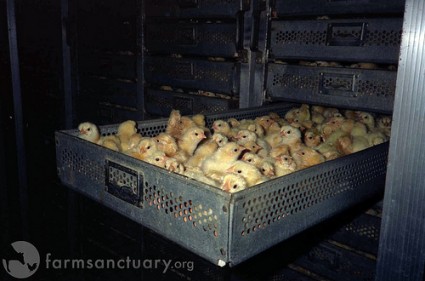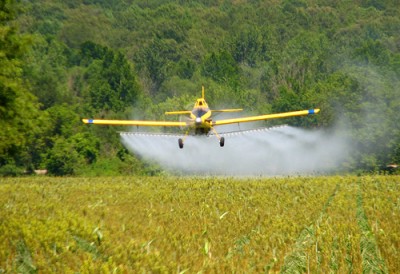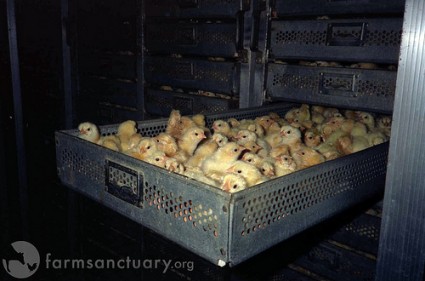 Incubating chickens–and what else? FarmSanctuary.org
Incubating chickens–and what else? FarmSanctuary.org
In Meat Wagon, we round up the latest outrages of the meat and livestock industries.
UPDATE below.
————————–
A bill now circulating in the House, sponsored by Rep. Louise Slaughter (D.-NY), would limit the amount of antibiotics that can be used on factory animal farms.
There’s good news and bad news on that front. The bad news: “The farm lobby’s opposition makes its passage unlikely,” The New York Times reported Monday. The farm lobby’s opposition is like that. But The Times should be more precise: it’s really the agribusiness lobby–representing a few large companies–that wields power.
Ok, now to the good news: Obama’s FDA has come out in support of restricting antibiotics. FDA official Joshua Sharfstein testified at a hearing sponsored by Slaughter that the agency will seek to limit antibiotic use on factory farms.
That marks a sea change. Until now, the FDA had been silent on the problem of antibiotic-resistant pathogens that develop on factory farms–even as evidence of their existence piled up.
Prevention magazine recently ran a pretty amazing story laying out the importance of the issue. The piece focused on MRSA, an antibiotic-resistant superbug that now kills more Americans every year than AIDS.
A growing body of research links MRSA to confined animal feedlot operations (CAFOs), where animals receive regular doses of antibiotics. The U.S. government has (until Sharfstein’s testimony) cravenly ignored the link.
The Prevention article, by Stephanie Woodard, recounts a frightening story I’d never heard before:
About two years ago, dozens of workers at a large chicken hatchery in Arkansas began experiencing mysterious skin rashes, with painful lumps scattered over their hands, arms, and legs.
Not long after, workers at a nearby slaughterhouse owned by the same company as the hatchery, “where hundreds of thousands of chicken carcasses are prepped daily for sale,” began turning up with similar symptoms.
The workers turned out to have come down with MRSA. No one has died yet; but some of the workers experience regular relapses.
Let’s think about this for a minute. We’ve got a bacterial brew at the hatchery: thousands of birds in close proximity swapping bacteria while feces piles mount beneath them. All the while, they’re fed a steady stream of antibiotics, which kill all but the most virulent and hearty strains. At the slaughterhouse, we’ve got workers working rapidly to disembowel and dismember those very birds along fast-moving conveyor belts. The latter conditions seem perfect for infecting workers with MRSA. Woodard quotes one slaughterhouse worker:
Even the safety glasses, gloves, and smocks workers wear (along with upgraded regular cleaning of equipment) aren’t enough to protect them, says [the worker]. “We work so fast, we often stick ourselves with knives or scissors and get blood on us from head to foot.” When a swelling rose over one of his eyes, he was told he might go blind; if the infection progressed to his brain, he’d die.
Woodard checked to see what food-safety authorities had done about the MRSA outbreak. Regular Meat Wagon readers will not be shocked at what she found:
Did any food safety agency test for MRSA in this plant’s chickens, which were then sold to the public and served on American dinner tables? Did any government organization determine the source of the outbreak? Calls to the USDA, CDC, and Arkansas Department of Health yielded a no to both questions; the poultry company that owns the operation did not respond to multiple requests for a comment from Prevention. Yet in recent years, studies have found MRSA in retail cuts of pork, chicken, beef, and other meats in the United States, Europe, and Asia.
Now, there are several layers of failure here; all point to a food-safety system under the heal of a hazardous industry. Indeed, the industry’s power is so frightful that the company’s name is withheld in Woodard’s article.
A little Google searching turned up an MRSA outbreak in Arkansas associated with a hatchery in close proximity with a slaughterhouse. It’s owned by Pilgrim’s Pride–the world’s largest chicken packer. Pilgrim’s Pride recently slouched into bankruptcy, brought low by a towering debt load and high corn prices. But the company has no lack of friends in high places.
For example, company leader “Bo” Pilgrim is famously cozy with Texas Gov. Rick Perry. At the ribbon cutting for Pilgrim’s Pride’s corporate HQ in Texas a few years ago, Perry strained to find the eloquence–and punctuation–to express the depth of his admiration for the enormous chicken packer.
Bo, one of the things that makes this company great is its history…
…because it proves that individuals who dare to dream big…
…who are willing to act on their ideas…
…and who stay true to their values can accomplish amazing things.
Last year, “Bo” shoveled all kinds of cash into Perry-related coffers.
While “Bo” and Rick were playing bump-and-tickle, things are less jolly at those Arkansas facilities, as this article from a local Arkansas paper shows.
It’s too early to tell whether Obama’s FDA can sufficiently crack down on the meat industry to stop MRSA in its tracks. But at least the agency is, at long last, acknowledging the problem.
UPDATE: Lest anyone head into the weekend feeling too optimistic about the FDA’s take on antibiotics and factory farms, here’s the take of the folks who wrote the book, below find the take of the Pew Campaign on Human Health and Industrial Farming. Sharfstein had called for the phaseout of antibiotics aimed at promoting rapid growth. Good start, but not enough. Here’s Pew:
While banning the use of antibiotics for growth promotion is an important step forward, we need to ensure that antibiotics are not used to compensate for unsanitary conditions on many industrial farms.
The proposed FDA position does not go far enough in this regard and would allow the continuation of conditions that necessitate the improper use of antibiotics in the first place. Successful models already exist in the U.S. where millions of animals on large industrial farms can be raised cost-effectively without the routine use of antibiotics.
Congress should pass H.R. 1549, the Preservation of Antibiotics for Medical Treatment Act of 2009, to ensure that these important medicines work as intended, to cure infections and protect human health. [Emphasis added.]
However, I’m not convinced that industrial animal farming is possible without routine antibiotic use. Stuffing animals together over their own shit essentially ruins their immune systems; antibiotics keep them alive long enough to reach slaughter weight. The industry’s very business model may be the root of the problem–fixing it might mean slaughtering the meat industry istelf, and returning to smaller scale, pastured-based meat-production models. That would mean significantly less meat in our diets. No doubt, though, H.R. 1549 represents a step forward. It will be passed–it at all–over the meat industry’s dead body. And I mean that literally–sort of. Hat tip to Maryn McKenna’s blog Superbug, which should be on every MRSA watchers RSS feed.




